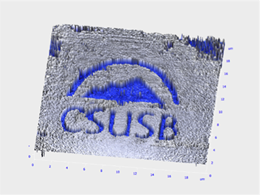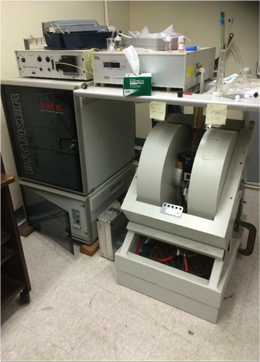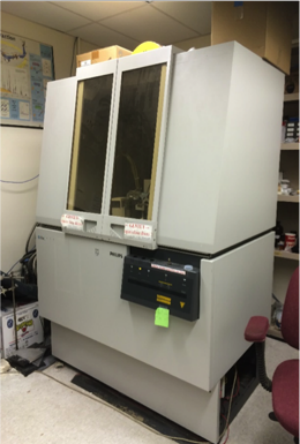
NT-MDT NEXT/NANO AFM
An essential and notable feature of the NT-MDT NEXT/NANO Atomic Force Microscope (AFM) system is its unique ability to serve as both a research and instructional need. The NEXT configuration of the system can perform high resolution atomic force microscopy (AFM) and piezo response force microcopy (PFM). The NANO configuration of the system is ideally suited for performing scanning tunneling microscopy (STM) needed for research, in addition to the AFM using both commercial cantilever probes and inexpensive home-made STM probes. The SOLVER NANO component of the system offers training for the research students in AFM techniques using low-cost home-made STM probes.
Computational Chemistry Workstation
Mac Pro (OS X 10.7.5) with 2x2.4 GHz 6 core Intel Xeon processors, 32 GB 1333 MHz DDR RAM, 3 TB HD.
Software
VASP 4.6 (mutiprocessor mode), CCDC package 2013, GAMESS (multiprocessor mode), Avogadro, VESTA, WebMO, VMD, and Spartan 10 (multiprocessor mode).

EPR Spectrometer
Bruker EMX x-band spectrometer, equipped with a high Q resonator, wide band amplifier and a high precision frequency counter. In addition to the low temperature system listed below, the epr spectrometer has a liquid nitrogen cryostat system. The spectrometer is also equipped with a custom goniometer.
Ferroelectric Tester
Radiant Technologies multiferroic material analyzer, which is an advanced modification of the Precision II tester, allowing measurements up to 50 kHz. A Trek model 609B high voltage (10kV) amplifier. Is integrated into the system via a Radiant Technologies HVII high voltage interface link. This is important due to the high cohesive fields for recently discovered organic ferroelectrics. Radiant Technologies High Voltage test fixture. In addition to hysteresis loop measurement, other measurements include: Leakage current, charge, I/V, fatigue, C (V), PUND, imprint, remnant hysteresis, small signal CV, and retention. We have recently integrated this test system with the NT-MDT NEXT/NANO AFM system noted above. We are the first lab to integrate these who commercial systems.
Closed Cycle Cryogenic System
Advanced Research Systems (ARS) Diplex closed cycle cryogenic system, specially modified for use with the epr and x-ray diffraction systems. Of course the system can also be used with the ferroelectric test system described above. This system is capable of temperatures from 10K to above room temperature without the use of liquid cryogens.
SEM with EDX and Backscatter
Hitachi 2600 Scanning Electron Microscope with EDX Energy Dispersive X-Ray System, operated by 4Pi Analysis software. There is also a Robinson Backscatter Electron Detector.
Closed Cycle Cryogenic System
Advanced Research Systems (ARS) Diplex closed cycle cryogenic system, specially modified for use with the epr and x-ray diffraction systems. Of course the system can also be used with the ferroelectric test system described above. This system is capable of temperatures from 10K to above room temperature without the use of liquid cryogens.
Piezoelelctric
MTI Instruments, model MTI 2000 fotonic sensor, which is fully integrated into the Radiant Technologies test system, thereby allowing simultaneous measurements of piezoelectric 'butterfly curves' and hysteresis loops.

X-ray diffractometer
Panalytical X-pert x-ray powder diffractometer equipped with a 8 - 28 goniometer and a programmable receiving slit and a copper target tube.
X-ray Fluorescence
Four NITON Gold+ handheld x-ray fluorescence element detectors , courtesy of a grant from the W.M. Keck Foundation.
SEM with EDX and Backscatter
Hitachi 2600 Scanning Electron Microscope with EDX Energy Dispersive X-Ray System, operated by 4Pi Analysis software. There is also a Robinson Backscatter Electron Detector.
Tube Furnace
Lindberg 1200°C Split Hinge Three Zone Tube Furnace, 36' Heated Length. Lindberg Inconel Tube Furnace Retort. This will allow measurements well above room temperature and/or at pressures below and above atmosphere.
Facilities
A 267 square foot room in the Physical Sciences building (PS-005) was recently renovated as the first dedicated instrument room for Materials Science. Materials Science research also takes place in seven faculty labs and in shared facilities in the PS, BI and CS building. In addition, a materials science project lab is planned for the new ISLAB building, currently number one on the campus priority list for new funding.